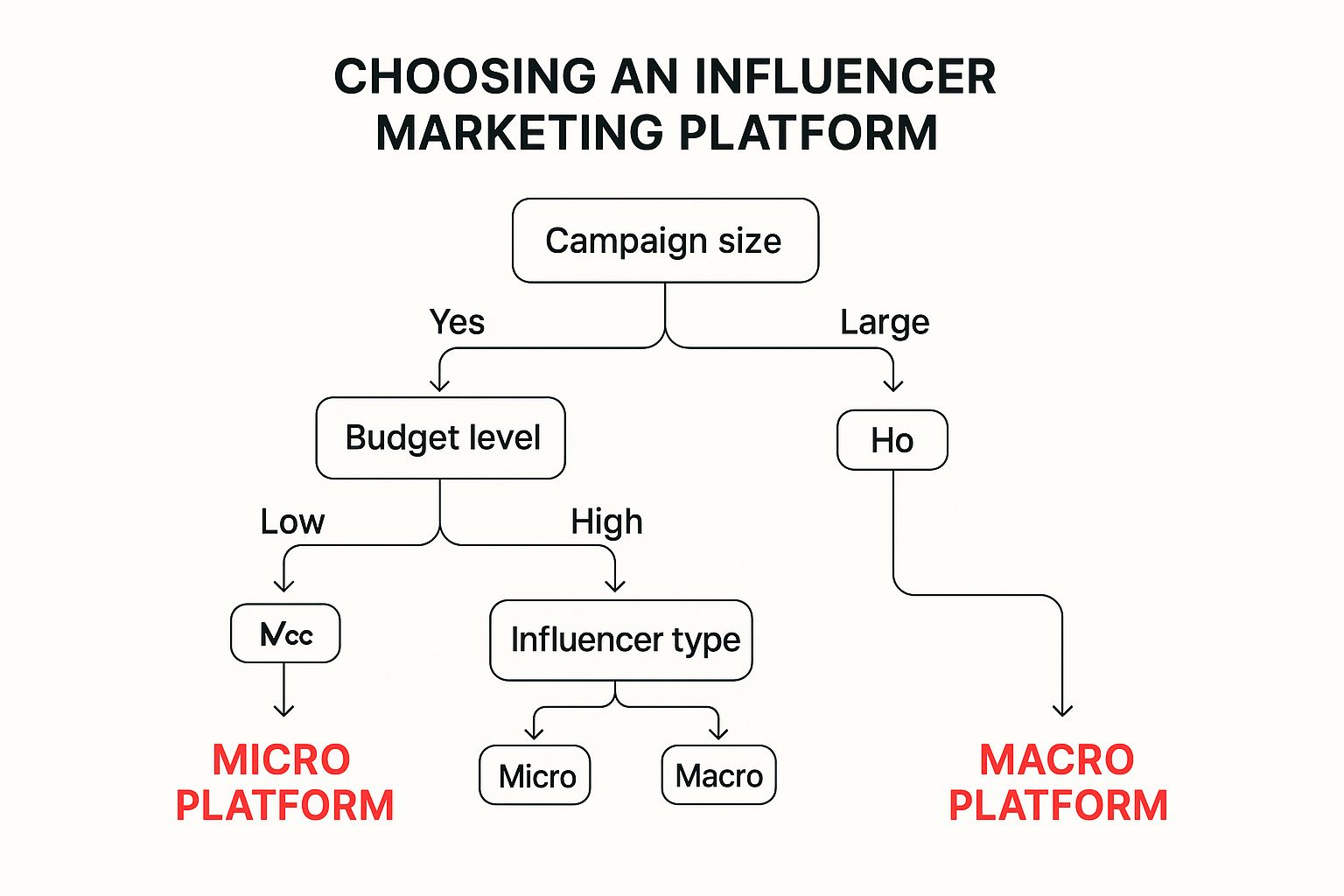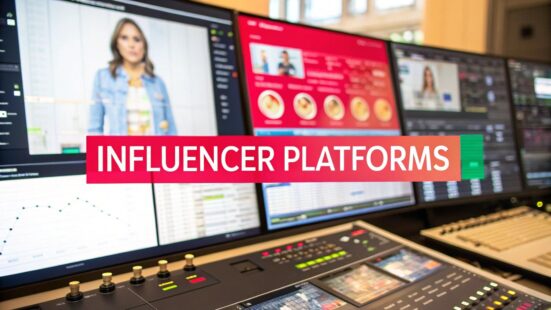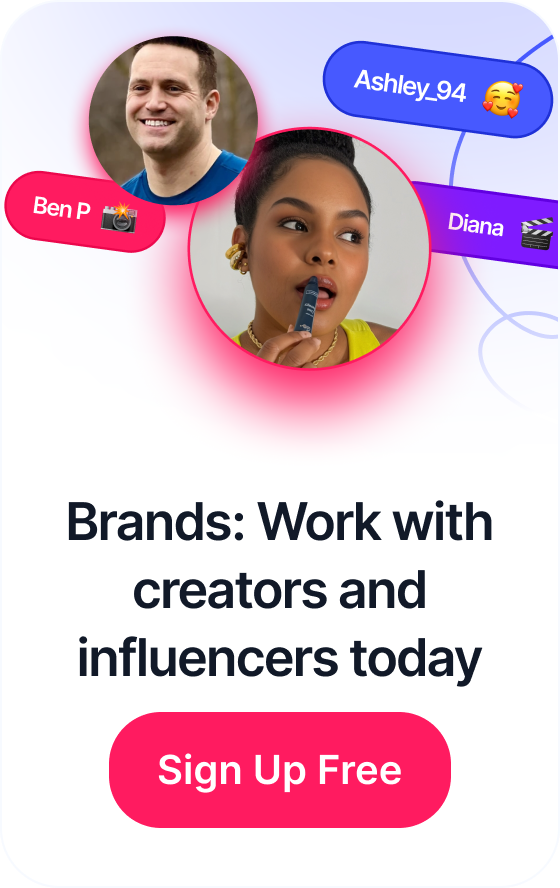 influencer marketing example: 10 standout campaigns
influencer marketing example: 10 standout campaigns
Ever tried to manage a big project with a team scattered across the globe, using only sticky notes and carrier pigeons? That’s pretty much what scaling your influencer marketing feels like without the right software. It's a chaotic mess of spreadsheets to track creators, never-ending email chains for approvals, and manual bank transfers for payments.
An influencer marketing platform is the mission control center that finally ends all that chaos.
Table of Contents
What Are Influencer Marketing Platforms?
Think of it as the central operating system for your entire influencer strategy. It’s a comprehensive software solution designed to bring every single piece of your creator partnerships under one roof. For ambitious DTC and e-commerce brands, making this leap from manual madness to an automated, strategic approach is absolutely essential for growth.
From Manual Hassle to Strategic Engine
Without a dedicated platform, marketers are just setting themselves up for headaches that stunt their program's potential. A huge pain point is simply discovering authentic creators whose audience actually matches the brand's target customer. The process can feel like searching for a needle in a digital haystack.
An influencer marketing platform solves these core problems head-on.
- Efficient Discovery: Instead of mindlessly scrolling through social media feeds, you can use powerful filters to pinpoint creators based on specific audience demographics, engagement rates, content quality, and more.
- Streamlined Management: It pulls all your communication, content approvals, and contracts into a single, organized workflow. This alone can save you countless administrative hours every week.
- Data-Driven Decisions: These tools give you the hard numbers. You get analytics to track key metrics like reach, engagement, and most importantly, conversions, allowing you to finally prove the ROI of your campaigns to stakeholders.
For brands specifically looking to find and manage content creators for user-generated content, exploring various UGC creator platforms can offer a ton of valuable insights into the market and the different tools available.
To put it simply, here’s how these platforms turn common brand struggles into streamlined solutions.
Key Platform Functions at a Glance
| Common Challenge | Platform Solution |
|---|---|
| Finding relevant, authentic creators is slow and manual. | Advanced Discovery Tools: Search and filter creators by niche, audience data, and performance metrics. |
| Managing dozens of conversations across email and DMs. | Centralized Communication Hub: Manage all outreach, negotiations, and messaging in one place. |
| Tracking campaign progress is a spreadsheet nightmare. | Automated Campaign Management: Oversee content approvals, posting schedules, and creator tasks. |
| Proving the ROI of influencer marketing is difficult. | Real-Time Analytics & Reporting: Track key performance indicators (KPIs) like sales, clicks, and ROI. |
| Handling contracts and payments is time-consuming. | Integrated Legal & Payments: Generate contracts and automate creator payments securely. |
This shift from manual grunt work to strategic oversight is what allows brands to truly scale their efforts.
An influencer marketing platform transforms a time-consuming, administrative task into a powerful, data-driven marketing engine. It provides the scale and precision needed to turn creator partnerships into a predictable source of growth.
The demand for these tools is exploding for a reason. The global influencer marketing platform market was valued at USD 25.44 billion in 2024 and is on track to hit nearly USD 97.55 billion by 2030. You can find more details on this growth via Grand View Research. This massive growth just goes to show how indispensable these platforms have become for modern marketing teams.
By centralizing everything, these platforms empower brands to build more authentic, scalable, and profitable influencer programs that drive real results.
What The Best Influencer Marketing Platforms All Have in Common
Not all influencer marketing platforms are built the same. A lot of them promise the world, but the ones that actually deliver share a core set of features. These aren't just bells and whistles; they're the non-negotiables that turn a chaotic, manual mess into a streamlined, strategic marketing engine.
Getting a handle on these key components is crucial. It helps you see past the flashy sales pitches and zero in on the software that will genuinely solve your problems. Think of it like this: you could buy a simple hammer, or you could invest in a full toolkit. Both can hit a nail, but only one gives you what you need to build something real and lasting.
AI-Powered Influencer Discovery
Let's be honest, the biggest hurdle is finding the right creators. Manually scrolling through social media feeds isn't just painfully slow—it’s a shot in the dark. The best platforms solve this with some seriously smart, AI-driven discovery tools. It’s like having a hyper-intelligent search engine just for people.
You can slice and dice a massive database of creators using dozens of specific filters:
- Audience Demographics: Find influencers whose followers actually match your ideal customer profile—think age, location, gender, and interests.
- Performance Metrics: Get an instant look at the data that matters, like engagement rates, average video views, and follower growth trends.
- Content Keywords: Search for creators who are already talking about topics related to your brand or niche. It’s a huge head start.
- Audience Authenticity: This is a total game-changer. These tools can sniff out fake followers and bots, saving you from blowing your budget on vanity numbers.
This targeted approach means you’re not just guessing. You’re partnering with creators who have a real, genuine connection with an audience that’s primed to love your product.
Integrated Campaign Management Workflows
Okay, so you’ve found your perfect influencers. Now the real work begins. This is where having a central hub for everything becomes a lifesaver. Instead of drowning in endless email chains, DMs, and spreadsheets, a good platform pulls every single step of the campaign into one organized space.
Picture a project management board, but built specifically for creator collaborations. You can send out briefs, review and approve content, and keep track of posting schedules, all in one place. It creates a single source of truth for your team and your influencers, which cuts down on miscommunication and frustrating delays. Many top platforms are great at automating the grunt work. For a deeper dive into how this can work, check out these practical marketing automation workflow examples.
Creator Relationship Management (CRM)
Great influencer marketing isn't about one-and-done deals. It’s about building relationships that last. A platform with a built-in CRM helps you manage these partnerships as you scale, storing all the important info for every creator you've ever worked with (or even just considered).
A platform's CRM acts like your digital rolodex, tracking every conversation, past campaign result, payment detail, and even personal notes. This history is pure gold for quickly finding your top performers and turning them into long-term brand ambassadors.
With this feature, you can instantly see who knocked it out of the park last quarter and get them on board for your next launch—no need to start from scratch. For a wider look at other tools that can help, check out our guide on essential https://joinbrands.com/blog/influencer-marketing-tools/.
Automated Contracts and Payments
Let's talk about the administrative nightmare of contracts and payments. When you're working with dozens of creators, this can become a massive bottleneck. The best platforms automate this whole headache, saving your team countless hours and minimizing legal risk.
These systems can generate your standard contracts, get them digitally signed, and handle secure payouts once the work is done. It's not just about streamlining a logistical pain point; it builds trust and professionalism. Creators really appreciate brands that pay them on time, every time.
Advanced Analytics and ROI Tracking
This might just be the most important feature of all: the ability to actually measure what matters. Modern platforms provide powerful analytics dashboards that go way beyond surface-level metrics like likes and comments. They connect the dots between influencer activity and real business outcomes.

You can finally track the KPIs that your boss actually cares about, like website clicks, conversion rates, and the holy grail—return on investment (ROI). With solid data in hand, you can prove the value of your influencer program and make smart decisions to get even better results next time.
Strategic Benefits for Ecommerce Brands

The real magic of an influencer marketing platform isn’t just about fancy features; it's about what it actually does for your business. For any e-commerce or DTC brand, this means turning influencer marketing from a "let's hope this works" brand play into a predictable, performance-driven sales machine.
Think about a small DTC skincare brand, let's call them "Glow Labs." They started out doing everything by hand—endless hours scrolling through hashtags, sliding into DMs, and trying to track everything in a messy spreadsheet. They got a few collaborations off the ground, but it was slow, impossible to scale, and they had zero real data to prove if it was actually selling products. It felt more like gambling than marketing.
Then, they brought on an influencer marketing platform, and everything changed. The spreadsheet chaos and DM-sliding were gone, replaced by a streamlined command center.
From Manual Chaos to Scalable Growth
The first thing you'll notice is the ability to grow your program without having to grow your team. For Glow Labs, a task that used to eat up an entire day—like finding and vetting just five potential creators—now takes less than an hour. These platforms give you the foundation to manage hundreds of creator relationships as easily as you used to manage a handful.
But this isn't just about managing more people; it's about finding the right people. You get access to a massive, searchable database that helps you uncover those perfect-fit niche creators—the ones you'd never stumble upon through manual searching alone.
This single shift unlocks some huge advantages:
- Program Expansion: Easily take your program from 10 partners to 100, running multiple campaigns at once without breaking a sweat.
- Time Reclamation: Automate all the boring stuff—outreach, contracts, payments—so your team can focus on building real relationships and thinking strategically.
- Diverse Partnerships: Effortlessly test out different tiers of creators, from nano-influencers driving authentic engagement to macro-influencers delivering massive reach.
Turning Influence into a Measurable Sales Channel
This is the big one for e-commerce brands: the move away from vanity metrics to cold, hard sales data. Before, Glow Labs was stuck reporting on likes and comments. Now, they can track every single click, discount code redemption, and dollar generated from each influencer.
An influencer marketing platform gives you the data-driven clarity to prove value. It turns creative partnerships into a measurable sales channel, proving its ROI with the same confidence you have in your paid ad campaigns.
This data-backed approach is no longer a "nice-to-have." A recent study found that over 80% of marketers view influencer marketing as a highly effective way to hit their business goals. They're putting their money where their mouth is, too, with nearly 64% of brands planning to work with influencers in the next year. You can discover more insights from the Influencer Marketing Hub benchmark report to see just how critical this channel has become.
Making Smarter Investments with Verified Data
Finally, these platforms take the guesswork out of where you put your money. Forget relying on an influencer's self-reported stats or a questionable screenshot of their analytics. You get access to verified, third-party data on their audience demographics, engagement rates, and past performance.
This means you can invest your budget with confidence, knowing you're paying for creators whose followers are actually your target customers. For our friends at Glow Labs, this meant reallocating budget from a creator with a huge but irrelevant following to a smaller micro-influencer whose audience converted at three times the rate.
That's the kind of precision that's only possible with the deep analytics found in top-tier influencer marketing platforms. It ensures every dollar you spend is working as hard as it possibly can.
How to Choose the Right Platform
Picking the perfect influencer marketing platform can feel a lot like trying to find the right key for a lock you’ve never seen. With dozens of options all promising the moon, it’s easy to drown in feature lists and slick sales demos.
But here’s the secret: the goal isn’t finding a platform with the most features. It’s about finding the one with the right features for your specific business goals. A thoughtful, informed decision starts with asking the right questions—not just of the platform’s sales team, but of your own. This framework will help you cut through the noise and find a tool your team will actually use and love.
Start With Your Budget And Business Model
First things first, let’s talk money. Influencer marketing platforms come with different price tags and models, and you need to know what you're getting into to avoid any nasty surprises down the line.
Subscription Models (SaaS): This is the most common setup. You pay a recurring monthly or annual fee for access to the platform's toolkit. It's a great fit for brands that need predictable costs and plan on running campaigns consistently all year.
Commission-Based Models: Some platforms will take a slice of your total campaign spend or influencer payout. This can be a smart choice for brands just dipping their toes in the water, since the costs scale directly with your program's size.
Hybrid Models: Plenty of platforms mix and match. They might have a base subscription fee plus usage-based charges, like paying for each influencer you contact or every report you pull. Get crystal clear on what's included in that base fee so you don't get hit with unexpected bills.
The right model really depends on your campaign frequency and scale. A high-volume e-commerce brand might get more bang for their buck from a fixed subscription, while a startup running a single launch campaign might prefer a commission-based approach.
Align Platform Features With Your Core Needs
Once you’ve got a handle on the budget, it’s time to match a platform’s capabilities with what you actually need to get done. A platform that’s a dream for a B2B software company could be a total nightmare for a DTC fashion brand.
To help you picture it, the decision tree below maps out how things like your campaign size and influencer focus can nudge you toward the right type of platform.

As the visual guide shows, a brand with a smaller budget that’s all-in on micro-influencers has wildly different needs than a huge enterprise working with macro-influencers. For an even deeper dive, our guide to compare influencer platforms gives you a side-by-side analysis of the top players.
Create Your Own Evaluation Checklist
It’s so easy to get wowed by flashy features during a demo that, let’s be honest, you’ll probably never use. That’s why you need to walk into every conversation with a clear checklist of your non-negotiables.
I put together this table to help you organize your thoughts. Before you talk to any sales reps, sit down with your team and fill out that "Priority" column. It'll keep you focused on what truly matters.
Platform Selection Criteria Checklist
| Criteria | What to Look For | Your Priority (High/Med/Low) |
|---|---|---|
| Influencer Database | Database size, creator vetting process, authenticity scores, and filters for audience demographics (age, location, interests). | |
| E-commerce Integration | Does it connect directly with Shopify, WooCommerce, etc.? Can it track sales with discount codes and affiliate links? | |
| Campaign Workflow | How intuitive is it to create a brief, invite creators, approve content, and process payments? | |
| Product Seeding Tools | Are there built-in features to manage the logistics of shipping products to creators? (A must for DTC brands). | |
| Communication | Is there a centralized messaging system to talk with influencers, or do you have to manage it all via email? | |
| Analytics & Reporting | Can you build custom reports that track your key KPIs, like conversion rate, ROAS, and customer acquisition cost? | |
| Content Management | Can you easily collect and organize all the user-generated content (UGC) from your campaigns? Are there content usage rights features? | |
| User Interface (UI/UX) | Is the platform easy to navigate? How steep is the learning curve for your team? | |
| Support & Onboarding | What level of customer support is offered? Is there a dedicated account manager or just a help desk? |
Having this checklist handy will force you to compare apples to apples and make a decision based on your real needs, not just a slick presentation.
Run An Effective Trial Period
Last but not least, never, ever commit to a long-term contract without a proper trial. This is your chance to pressure-test the platform in a real-world scenario. Don't just click around—run a small, controlled campaign from start to finish.
This hands-on experience will tell you more than any demo ever could. You’ll find out pretty quickly if the workflow feels natural for your team and if the tool genuinely solves your biggest headaches. Choosing the right influencer marketing platform is a big investment, but by following a structured evaluation process, you can make sure it’s one that pays off for years to come.
Getting the Most Out of Your Platform Investment

Signing up for an influencer marketing platform is a big move, but the tool itself is only half the battle. Think of it like buying a professional-grade camera; just owning it doesn't automatically make you a world-class photographer. Real success comes from the strategy you build around it and how well you use it.
To actually see a return on your investment, you have to treat the platform as more than just software. It’s a strategic asset. The goal is to turn that monthly subscription fee into a reliable, revenue-driving engine for your brand. That means you need to be proactive long before you even think about launching a campaign.
The entire foundation of a high-ROI program starts with one thing: setting crystal-clear goals right from the jump. Without a North Star to aim for, your campaigns will feel random and the data you collect will be pretty much useless.
Nail Down Your Campaign Objectives
Before you even browse a single creator profile, you have to decide what success actually looks like for your brand. Are you trying to get your name out there? Drive direct sales? Or maybe just stock up on killer content for your own social feeds? Each of these goals demands a totally different strategy and a different type of influencer.
For Brand Awareness: Your focus will be on metrics like reach, impressions, and engagement rate. Here, you might lean towards macro-influencers who can blast your brand out to a massive audience.
For Direct Sales: It's all about conversion rates, click-through rates (CTR), and return on ad spend (ROAS). Your game plan will likely involve trackable affiliate links, unique discount codes, and micro-influencers with super-engaged, niche followers.
For Content Generation: The win here is getting a library of high-quality user-generated content (UGC) you can repurpose. You'll measure success by the sheer volume and quality of the photos and videos you receive.
Knowing your objective means you can use your platform’s analytics to track what really matters. This simple step is what separates throwing money at the wall from making a smart, calculated investment.
Play the Long Game with Creator Relationships
One of the biggest mistakes brands make is treating influencer marketing like a series of one-off transactions. Constantly chasing new creators for every single campaign is exhausting, inefficient, and it doesn't build any real brand love. Your platform’s CRM feature is the perfect tool to shift from this transactional mindset to a much more profitable, relationship-based one.
The real magic of an influencer marketing platform happens when you use it to find and nurture your top-performing creators. Turning these partners into long-term brand ambassadors is how you generate authentic, compounding returns over time.
Think about it. A creator who genuinely loves your product and has worked with you for months will create content that feels way more authentic and persuasive than someone you just hired for a single post. Use your platform’s data to see which influencers drove the most sales or engagement in past campaigns. Then, pour your energy into building lasting partnerships with them.
This approach doesn't just improve your content quality; it often leads to better rates and a creative process that feels more like a true collaboration.
Constantly Tweak and Refine with Platform Analytics
Your platform’s analytics dashboard is your roadmap to a higher ROI. It’s feeding you a constant stream of performance data, telling you exactly what’s working and what’s a dud. Don't just glance at these reports after a campaign is over; use them as a live feedback loop to make smarter decisions on the fly.
For example, your data might show that your nano-influencers are driving a 3x higher conversion rate than your mid-tier partners, even with a smaller reach. That’s a massive signal to shift more of your budget toward nano-influencers for your next sales-focused push.
Or you might discover that Instagram Reels generate 50% more engagement than static posts. Use that insight! Adjust your content briefs and double down on the formats that are clearly resonating with your audience. The return from well-executed campaigns can be huge. Brands often see an average return of around six and a half dollars for every dollar spent, with the best campaigns hitting multiples as high as 20 times the initial investment. To dig into these numbers, you can learn more about influencer marketing ROI statistics.
The Future of Influencer Marketing Platforms
The world of influencer marketing moves ridiculously fast, and the platforms powering it are racing to keep up. The tools we rely on today are really just setting the stage for a future that's smarter, more connected, and built around the creator.
When you're picking a platform, you're not just solving today's workflow issues. You're betting on a partner who can get you ready for what's coming next.
The biggest change is already happening, and it’s all about AI. Right now, most platforms use AI for the basics, like finding influencers and sniffing out fake followers. But the next leap forward is all about predictive analytics.
Just imagine a tool that doesn't just show you an influencer's past stats, but actually forecasts their potential success for your specific campaign. AI will crunch millions of data points to predict which creator will drive the best ROI for your new product launch—before you spend a single dollar.
The Rise of Creator-Centric Tools
The power dynamic has officially shifted. Influencers aren't just channels to broadcast a message anymore; they're becoming genuine business partners. The most forward-thinking influencer marketing platforms are getting this and building tools that empower creators, going way beyond simple campaign management.
This evolution is bringing features that make deeper, more meaningful collaborations possible, like:
- Product Co-Creation Workflows: Imagine tools that let you and a creator actually design and launch new products together, all within the platform.
- Long-Term Ambassadorship Management: These are features built to manage multi-year partnerships, complete with performance incentives and ways to track growth over time.
- Integrated Monetization Options: Platforms are starting to help creators run their entire business—from generating media kits to processing direct payments—turning them into true entrepreneurs.
The next generation of platforms will treat creators like valued partners, not gig workers. This fosters the kind of authentic, long-term relationships that deliver way more value than a few one-off sponsored posts.
Deeper Integration and Smarter Automation
As our digital world spreads out across more and more channels, having everything integrated is becoming non-negotiable. The best platforms are working to unify campaign management across every important touchpoint—TikTok, YouTube Shorts, and even those new live streaming services that pop up. This creates one central place to see how your entire multi-channel campaign is doing.
This deep integration is also getting a major boost from AI-driven automation. A whopping 73% of marketers believe AI could automate large chunks of the influencer marketing process, making things more efficient without losing that personal touch. Discover more insights about AI's role in influencer marketing statistics.
What this means is that soon, platforms will handle tasks like the initial outreach emails, generating contracts, and pulling performance reports with very little help from you.
Ultimately, the future of these platforms is all about building smarter, more efficient, and more collaborative ecosystems. By embracing predictive AI, empowering creators as real partners, and connecting seamlessly across every channel, these tools will set your brand up to win—not just today, but in the creator economy of tomorrow.
Frequently Asked Questions
Jumping into the world of influencer marketing platforms can feel a bit like learning a new language. You're bound to have questions, especially when you're first getting started with these powerful tools. Let's clear up some of the most common ones we hear from brands.
What Is The Average Cost Of An Influencer Marketing Platform?
The price tag on these platforms can swing pretty wildly, and it all comes down to what you need.
Entry-level tools might start around a few hundred dollars a month. These are great for smaller-scale campaigns and usually give you the basic features to get going. On the other end of the spectrum, advanced enterprise platforms can cost several thousand dollars monthly. For that price, you're getting massive creator databases, deep analytics, and dedicated support. Most platforms offer tiered subscription plans, so you can start small and scale up as your program finds its footing and starts to grow.
Do I Still Need To Pay Influencers Separately?
Yes, absolutely. Think of the platform fee as the cost of admission—it pays for the software itself, giving you access to all the discovery, management, and reporting tools.
The money you pay creators for their hard work is a completely separate cost. This includes everything from flat fees and commissions to the cost of the products you send out for seeding campaigns. The platform just makes it a heck of a lot easier to manage, track, and automate those payments.
Key Takeaway: The platform is your operational command center; your influencer budget is what pays for the creative talent. A solid platform makes managing that talent budget way more efficient and data-driven.
How Do Platforms Handle Legal And Compliance Issues?
This is a big one. Most top-tier platforms have you covered with built-in contract templates and digital signature features to make your agreements official.
While these tools are a massive help, it’s still on your brand to know the rules of the road. Things like proper disclosure are completely non-negotiable. It's always a good idea to get familiar with the official FTC guidelines for influencers to make sure every campaign you run is buttoned up and compliant.
The best influencer marketing platforms are built to guide you in following these rules by making transparency a key part of the workflow. At the end of the day, though, the final responsibility always lies with your brand.
Ready to stop the manual grind and start scaling your creator partnerships? With JoinBrands, you can access a network of over 250,000 creators, streamline your campaign management with AI-powered tools, and drive real sales. Find your perfect creators and launch your next campaign today.








